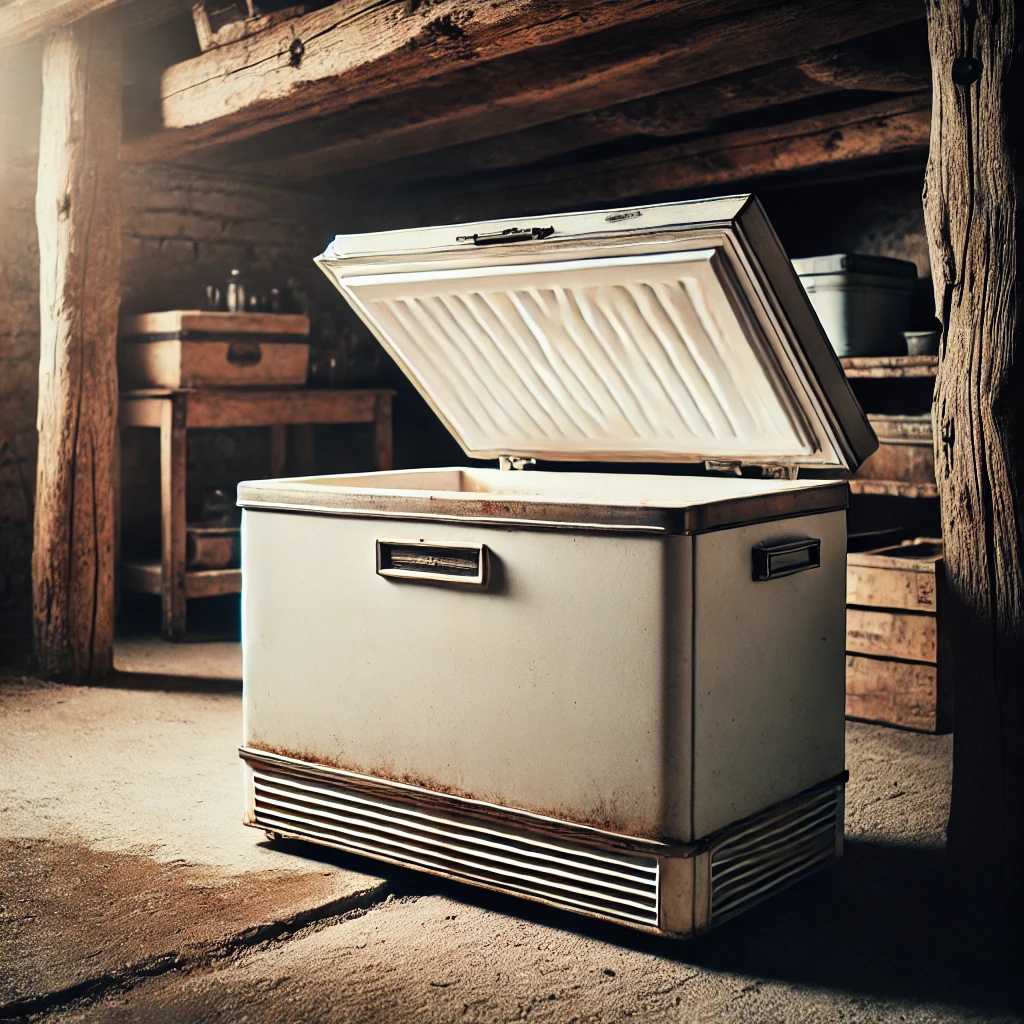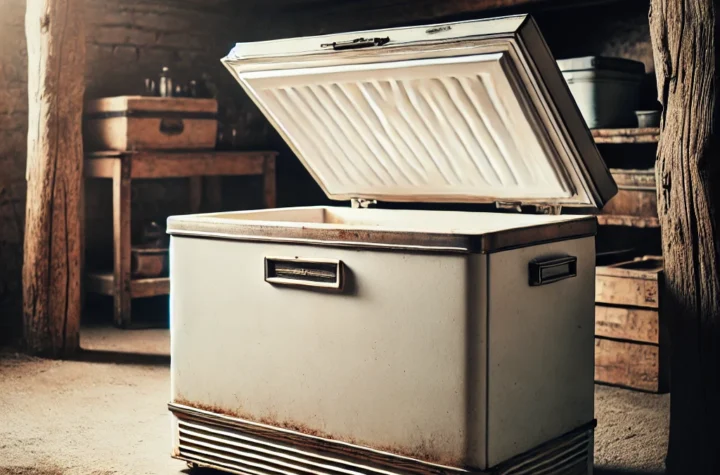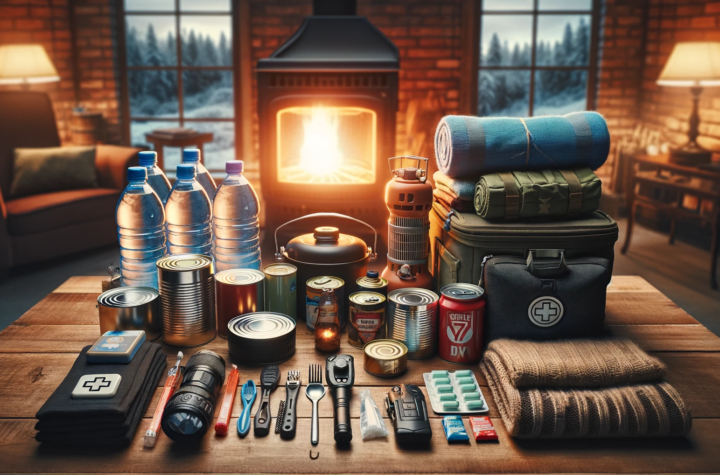
AI generated illustration image
In the event of a massive power outage, how long your freezer will last largely depends on how full it is, the type of freezer you own, and the steps you take to preserve its cold environment. Typically, a full freezer can keep food frozen for about 48 hours if you refrain from opening the door, while a half-full freezer can maintain safe temperatures for approximately 24 hours. These estimates are based on data from the U.S. Department of Agriculture (USDA), which also advises that keeping the door closed is the most critical factor in extending the freezer’s ability to maintain cold temperatures (USDA, 2021).
Stockpile
Building a stockpile of shelf-stable foods—such as canned goods, grains, and legumes—before the outage would prove invaluable for enduring such an extended crisis. If you want that shelf-stable stockpile to be “set-it-and-forget-it,” then buckets of freeze-dried food would be an excellent option, as they can last for upwards of 30 years with minimal maintenance. These foods are lightweight, easy to store, and require only water to rehydrate, making them highly practical for long-term emergencies. However, if you prefer a more dynamic approach to stockpiling, it’s essential to rotate your supplies regularly to ensure freshness and avoid waste. The simplest way to manage this is by stockpiling the foods you normally eat, ensuring they are consumed within their expiration date. By integrating your emergency supplies into your daily meals, you maintain a stockpile that is both practical and sustainable, giving you peace of mind while minimizing unnecessary costs.
Keep the door closed
The single most important thing you can do during an outage is to keep the freezer door closed as much as possible. Every time the door is opened, cold air escapes and is replaced by warm air, accelerating the thawing process. Resist the urge to check on your food unnecessarily. Instead, use a freezer thermometer to monitor the internal temperature without opening the door. According to the USDA, food remains safe as long as the temperature stays below 40°F (4°C). When you notice the temperature rising toward that threshold, it’s time to take additional measures.
Insulate
Insulating your freezer is a quick and effective way to slow down the warming process. Cover the freezer with blankets, quilts, or other insulating materials, but make sure you don’t block the vents, especially if power might return soon. These vents are essential for proper airflow and could cause damage if blocked. If you have access to ice or dry ice, use it to maintain lower temperatures. Dry ice is particularly effective, as it can keep a freezer cold for 24 to 48 hours, depending on the quantity used and the size of the freezer (USDA, 2021).
Grouping Items
Grouping the items in your freezer can also help extend its cooling capacity. Cold items grouped together share their low temperature and act as a thermal mass, slowing down the warming of individual items. If your freezer isn’t already full, consider filling empty spaces with frozen water bottles or ice packs before an outage occurs. These will act as additional thermal mass and can later serve as a source of cold drinking water. A well-packed freezer is more efficient at maintaining low temperatures (USDA, 2021).
Preparation
Preparation before an outage is crucial for maximizing your freezer’s performance. If you live in an area prone to power outages, consider keeping ice packs or containers of water frozen at all times. These simple additions can make a significant difference during an emergency. A freezer thermometer is another invaluable tool, allowing you to track internal temperatures and make informed decisions about food safety.
Backup power
Investing in a backup power source is another effective way to ensure your freezer remains operational during extended outages. Portable generators can be used intermittently to power your freezer, maintaining its low temperature for several hours at a time. Solar-powered battery systems are a quieter, more sustainable alternative that can provide power without the noise and fumes of a generator. The Federal Emergency Management Agency (FEMA) advises testing your backup power system regularly to ensure it works when you need it most (FEMA, 2023).
When the freezer starts to lose its cold temperature, using a cooler with ice packs can buy you extra time for your most essential items. Alternatively, underground storage options, such as cellars or shaded pits, can offer a cooler environment for storing food temporarily. Ground temperatures are generally lower than surface temperatures, particularly in shaded areas, making this a viable option for preserving some perishable goods.
8 months
But what if the outage isn’t just a matter of hours or days? Imagine a catastrophic scenario in which a massive solar flare knocks out power grids across the globe, leaving your region without electricity for eight months. Such an event would quickly surpass your freezer’s ability to keep food frozen, forcing you to adapt and pivot your strategy toward long-term survival.
In the first 48 hours, you would need to triage your freezer’s contents. Foods that are most perishable, such as seafood or dairy, should be prioritized for immediate consumption or cooked to extend their usability. The remaining items would need to be preserved using alternative methods. For example, meats could be smoked or dried into jerky, while fruits and vegetables could be canned or dehydrated. These preservation methods, while labor-intensive, would allow you to convert your frozen supplies into shelf-stable resources that could last for months.
Alternative power
Access to alternative power sources becomes critical in this scenario. A portable solar generator paired with energy-efficient appliances, such as a small chest freezer, could allow you to keep a limited amount of food frozen over the long term. Establishing a solar-powered water and energy system would further enhance your ability to manage daily needs. While these systems require an upfront investment, they provide a sustainable solution to extend your resilience during an extended outage.
12v
A 12V freezer can be a game-changer during extended power outages, especially in scenarios where traditional freezers are no longer functional. These compact, portable freezers run on 12-volt DC power, making them compatible with car batteries, portable power stations, or solar setups. They are highly efficient, often using far less energy than standard household freezers, and many models are designed to maintain subzero temperatures even in challenging conditions. Paired with a solar generator or a reliable battery bank, a 12V freezer can provide a sustainable solution for keeping essential items like meat, dairy, or medications frozen for weeks or even months. Their portability also allows for flexibility, enabling you to move them to safer or cooler locations as needed, making them an essential tool for long-term emergency preparedness.
Sustainable sources
As the months wear on, your focus would inevitably shift to creating sustainable food sources. Hunting, fishing, and gardening could supplement your preserved supplies, while bartering with neighbors or forming community networks might offer additional resources.
Conclusion
This type of long-term outage would test not just your preparedness but also your adaptability and ingenuity. By combining initial strategies—keeping the freezer closed, insulating it, and using ice or dry ice—with longer-term solutions like preservation techniques, solar power, and sustainable food sourcing, you could navigate even the most severe disruptions. Planning ahead for both short- and long-term emergencies ensures that you’re ready for any challenge, no matter how unexpected or prolonged it might be.





More Stories
How to Start Prepping: A Fun and Easy Guide to Being Prepared for a Week
The Golden Repository
Growing a Preparedness Garden